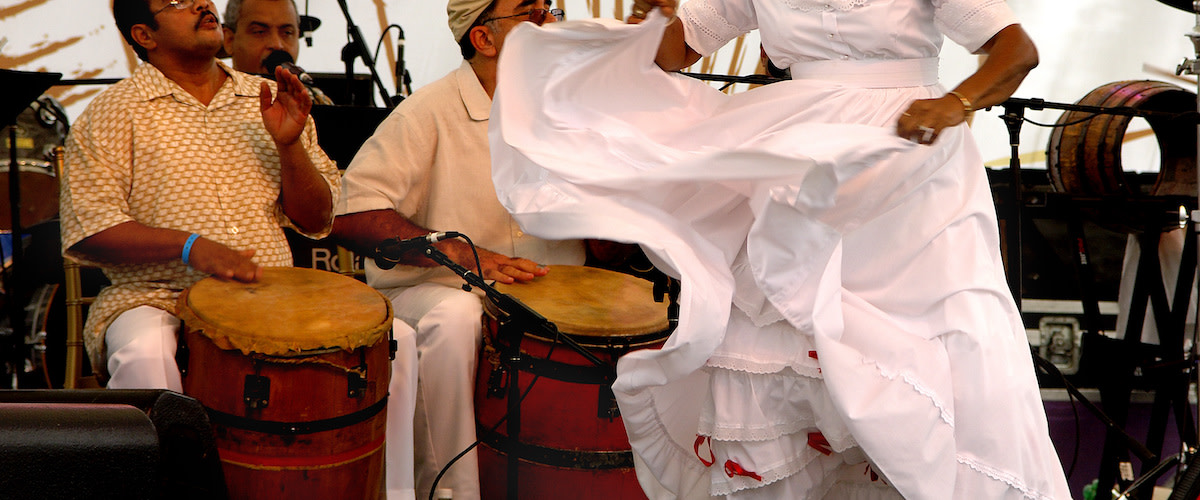Bomba Dance Guide: 4 Characteristics of Bomba Dance
Written by MasterClass
Last updated: Sep 17, 2021 • 3 min read
Bomba dance is a Puerto Rican dance with African roots where the dancers lead the musicians through lively improvisation and instantaneous creativity.
Learn From the Best
What Is Bomba Dance?
Bomba is an Afro-Puerto Rican musical genre and a corresponding style of traditional dance. During the Spanish colonial period, West Africans enslaved and living in Puerto Rico originated the dance, which is accompanied by the Latin American music style of the same name. Bomba is an improvisational style of dance that typically begins with a solo dancer stepping forward, as a group of percussionists (including drummers and maraca-players) accompanies their movements. The dancer uses their movements to converse with or react to the rhythm of the drums, specifically the subidor (a type of high-pitched drum).
A Brief History of Bomba Dance
During the Spanish colonial period beginning in the 1500s, the Spanish forcibly moved people from West Africa to Puerto Rico to work on sugar plantations as slaves. Some enslaved people turned to “bomba dances'' as a way to express themselves and communicate with one another. Bomba was performed at baptisms, marriages, and other celebrations (as well as instances of political rebellion) as a way for enslaved people from many different African communities to connect over a shared culture.
Over the centuries, the bomba dance continued to evolve, absorbing many different cultural influences, including that of the Taíno people (the people indigenous to Puerto Rico and other Caribbean islands), to develop a distinctly Puerto Rican dance style. The bomba dance spread throughout Puerto Rico in places like Loíza and San Juan, taking on different styles depending on the region, and becoming one of the most prominent and significant representations of Afro-Puerto Rican culture.
4 Characteristics of Bomba Dance
Bomba dance is intertwined with bomba music, as one requires the other for a successful ‘challenge.’ Here are five characteristics of bomba dance.
- 1. Dancer controls the rhythm and tempo. Unlike other dances, the featured bomba dancer controls the music with their footwork and other moves, and not the other way around. The performance is a challenge between the dancer and the drummer, who attempts to keep up with the dancer via the tempo of their playing. The dancer’s attitude will also influence the character of the music—be that upbeat and happy or downbeat and sorrowful.
- 2. Improvisational set-up. Bomba starts with a paseo (or promenade), when the dancer (or partners) slowly strolls around the dance space, signaling to the drummer that the challenge is about to begin. Following this, the bomba dancers then improvise their steps or arm movements, also known as piquetes.
- 3. Percussion accompaniment. The word ‘bomba’ refers to a style of Puerto Rican drum called barriles, which is made from a rum barrel covered in goatskin. The barriles serve as the basis of the beat and the dance. There are usually two drums, the first of which is the subidor (or primo), a high-pitched drum that improvises the beat along with the dancer. The second drum is a buleador, which has a low-pitched sound that creates the beat’s foundation. Maracas and a cuá (two wooden sticks used to hit the back of the drums) are also involved in creating the beat. While the bomba relies heavily on percussion, it can also feature a lead singer.
- 4. Full of feeling. The bomba dance isn’t about following a series of choreographed steps. It is about freely expressing the dancer’s emotions in a passionate and intense display. Bomba dances involve various projections of rage, sadness, or playfulness, with the movements following how the dancer is feeling or the message they want to convey.
3 Rhythms of Bomba Dance
There are three basic rhythmic styles of this Puerto Rican music and dance style that serve as the basis for over a dozen other derivatives. Here are the three main styles of Bomba dance.
- 1. Sicá: Sicá is the most popular and widespread type of bomba beat. The tempo for this rhythm is the slowest of the three main styles often associated with more sensual movements coming at the beginning of the dance narrative.
- 2. Yubá: The yubá is a moderately-tempo rhythm in 6/8 time, making it slightly faster than the sicá. This rhythm is associated with aggressive, powerful dance displays, as well as sadness and intensity. It is also played for the elderly and in regional variations of bomba performed in Cataño and Santurce.
- 3. Holandés: The holandés rhythm is used toward the end of a bomba dance, featuring an uptempo, syncopated rhythm. It is faster and more upbeat, with origins in the Dutch colonies of the Caribbean. This style is regional of Cataño and Mayagüez.
Learn More
Practice ballet with Misty Copeland, the principal dancer with the American Ballet Theatre. Get the MasterClass Annual Membership and learn how to put individual barre techniques together to create powerful performances and introduce artistry to your choreography.
